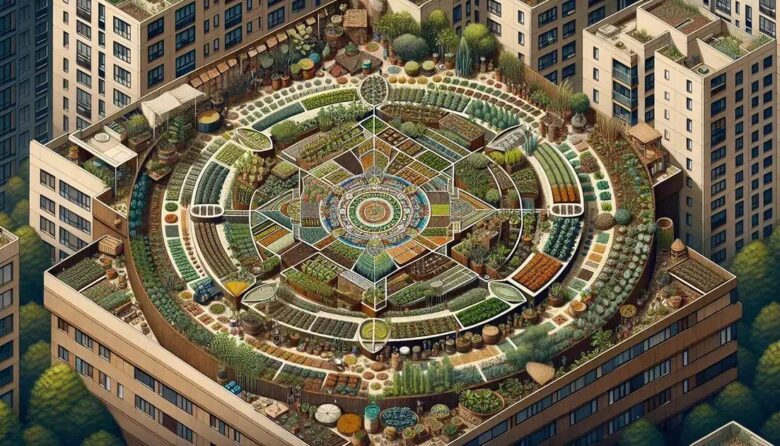Urban permaculture gardens transform limited city spaces into productive ecosystems by utilizing efficient designs like mandala gardens, promoting biodiversity, and engaging communities through sustainable practices such as vertical gardening, natural pest control, and water management, making cities greener and more self-sufficient.
Have you ever wondered how to transform urban spaces into lush green havens? The concept of mandala permaculture urban garden might be your answer. By creatively using small spaces, you can promote sustainable living and grow your haven. In this exploration, discover techniques that not only beautify your surroundings but also nurture the environment.
understanding the concept of mandala gardens
Mandala gardens are a fascinating approach to permaculture, typically arranged in a circular, symmetrical design that maximizes garden space efficiency. This layout not only enhances the visual appeal but also facilitates easier access to plants from any angle. Within a mandala garden, the key is to create a series of small, circular beds that are connected, forming intricate patterns that can resemble a blooming flower or geometric designs.
The central idea of a mandala garden thrives on the principles of permaculture, which emphasizes sustainable, regenerative agriculture practices. By utilizing this design, gardeners can optimize planting areas for sunlight exposure and create natural windbreaks. Such gardens often incorporate companion planting, where different species grow side by side to support each other, enhancing growth and deterring pests naturally. These designs are not only sustainable but also encourage biodiversity, promoting a healthier garden ecosystem.
In conclusion, mandala gardens are an excellent representation of how natural forms can inspire innovative agricultural practices that are both beautiful and environmentally friendly. They encourage creativity and offer a holistic approach to gardening, making them popular among urban enthusiasts looking to make the most of limited space.
benefits of permaculture in urban settings
Permaculture in urban environments offers a range of benefits that can transform cities into sustainable, regenerative communities. By applying these principles, cities can reduce their ecological footprint, improve food security, and enhance biodiversity. One of the primary advantages is the efficient use of space, allowing even small patios or balconies to become productive gardens.
Urban permaculture promotes self-reliance by encouraging local food production, which reduces dependency on long-distance food supply chains. This not only cuts down on transport-related emissions but also ensures fresh, nutritious food is available to city dwellers. Additionally, such practices can help mitigate urban heat, as the greenery helps to cool urban spaces.
Communities can benefit socially as well, as urban gardening fosters opportunities for collaboration and education. Neighbors working together on permaculture projects can strengthen social ties and share knowledge about sustainable practices. These green spaces provide a refuge for urban wildlife, increasing local biodiversity and improving the overall health of the ecosystem.
Permaculture also encourages the use of renewable resources and the recycling of waste, further enhancing sustainability. By integrating these practices, cities can serve as models for sustainable living, showcasing how local actions contribute to global solutions.
designing a mandala garden
Designing a mandala garden involves creating a layout that is not only aesthetically pleasing but also highly functional. Begin by choosing a central point, which acts as the focal point of your garden. Around this center, design a series of circular beds that radiate outward. These beds are typically arranged in geometric patterns like triangles or circles that intersect to form a mandala pattern.
When planning the layout, consider paths that allow easy access to each section of the garden. It’s important that the paths are wide enough for ongoing maintenance and harvesting. Use natural materials like stone or wood chips for the pathways to blend seamlessly with the garden’s organic look.
Incorporate companion planting principles to enhance your mandala garden. Plant species that benefit each other when grown together, such as tomatoes with basil or carrots with onions. This method not only optimizes space but also encourages a healthy ecosystem by attracting beneficial insects and deterring pests.
Choose plants based on the sunlight and water needs. Arrange sun-loving plants on the outer edges, while those needing more shade should be placed closer to the center or under taller plants. Consider integrating a water feature, which not only adds a serene element but also supports local wildlife.
step-by-step guide to starting your urban garden
Starting your urban garden can seem daunting, but following a clear step-by-step process makes it manageable and fun. Begin by assessing your space. Identify areas that receive adequate sunlight and have good drainage. Even small spaces like balconies or windowsills can be utilized effectively with containers or vertical gardens.
Decide on the type of garden that suits your needs. Consider vegetables, herbs, or flowering plants, depending on your goals and space constraints. Research which plants thrive in your climate and season. Local nurseries or garden centers can be helpful resources.
Prepare your soil by mixing garden soil with compost to enrich it with nutrients. Containers or raised beds are ideal for urban settings. Ensure they have appropriate drainage holes to prevent water logging.
Now, you’re ready to plant. Follow the instructions on seed packets or plant labels. Establish a watering schedule, keeping in mind that containers may need more frequent watering than ground plots. Mulching can help retain soil moisture, which is especially useful in dry regions.
Maintenance is key to a thriving garden. Regularly check for weeds and pests. Natural pest control methods, like neem oil or companion planting, can help protect your crops without harmful chemicals. Regularly review the growth of your plants and adjust your care routine as needed.
common challenges and solutions
Urban gardening presents several challenges, but with thoughtful planning, solutions are within reach. One common issue is limited space. To address this, consider vertical gardening or using small containers that maximize the area available. Creative use of walls or balcony railings can offer additional growing spaces.
Poor soil quality can also hinder growth. Enrich your soil by mixing in compost or using commercial soil enhancers. For areas with severely degraded soil, raised beds filled with high-quality soil are an excellent alternative. This approach also helps manage drainage issues, another frequent challenge in urban environments.
Pests and diseases can impact plant health. Employ natural deterrents like companion planting or introduce beneficial insects such as ladybugs to combat pests. Regular monitoring is crucial to catch and address issues early before they spread.
Water availability, especially in cities, can be erratic. Setting up a rainwater collection system or using self-watering planters ensures a steady water supply even during dry spells. Drip irrigation can also help conserve water, providing moisture directly to the roots.
real-life examples and success stories
Urban permaculture gardens have transformed many spaces, turning barren lots into thriving ecosystems. One inspiring success story is in New York City, where a community group turned a vacant lot into a lush permaculture garden. They used raised beds to grow vegetables and herbs, promoting biodiversity and creating a haven for urban wildlife.
In Los Angeles, a rooftop garden became a model for sustainable living. Residents planted fruit trees and vegetables, using rainwater harvesting systems for irrigation. This green oasis not only provides food but also reduces the building’s energy needs by cooling the structure naturally.
Another notable project in Chicago involved converting a city park into a permaculture teaching site. The space features a series of mandala gardens, where local schools conduct field trips for hands-on learning about sustainable agriculture. The initiative has strengthened community bonds and increased awareness of environmental issues.
These examples demonstrate how urban spaces can be creatively utilized, encouraging sustainable practices and community engagement. Each success story highlights the potential of permaculture to transform urban settings into vibrant, self-sustaining communities.
Embracing the Future of Urban Gardens
Urban permaculture gardens are more than just a trend; they represent a shift toward sustainable living in cities. By designing efficient gardens, utilizing permaculture principles, and overcoming common challenges, even small urban spaces can become productive and environmentally friendly.
The benefits of these gardens extend beyond food production. They also foster a sense of community, enhance biodiversity, and make cities greener and healthier. Real-life success stories prove that with creativity and commitment, urban gardening can transform landscapes and lives.
As more people embrace this movement, urban permaculture can lead the way to a more sustainable future. By implementing these practices, anyone can contribute to a global solution that nurtures our planet while feeding the community.
FAQ – Common Questions About Urban Permaculture Gardens
What is a mandala garden and how does it benefit urban settings?
A mandala garden is a circular garden layout that maximizes space and promotes efficient growth, ideal for urban areas with limited space.
How can permaculture practices be integrated into small urban spaces?
Permaculture can be applied through vertical gardening, container planting, and the use of native plants that thrive in urban environments.
What are some challenges of starting an urban garden?
Common challenges include limited space, poor soil quality, pests, and water management. Solutions include vertical gardening, soil amendments, and using natural pest control.
Are there real-life examples of successful urban permaculture projects?
Yes, cities like New York and Los Angeles feature community gardens and rooftop gardens that serve as successful examples of urban permaculture.
How does urban gardening contribute to community building?
Urban gardening fosters community by bringing people together to share resources, knowledge, and labor, strengthening social bonds.
What are the environmental benefits of urban permaculture?
Benefits include increased biodiversity, improved air quality, reduced urban heat, and providing habitats for wildlife.



